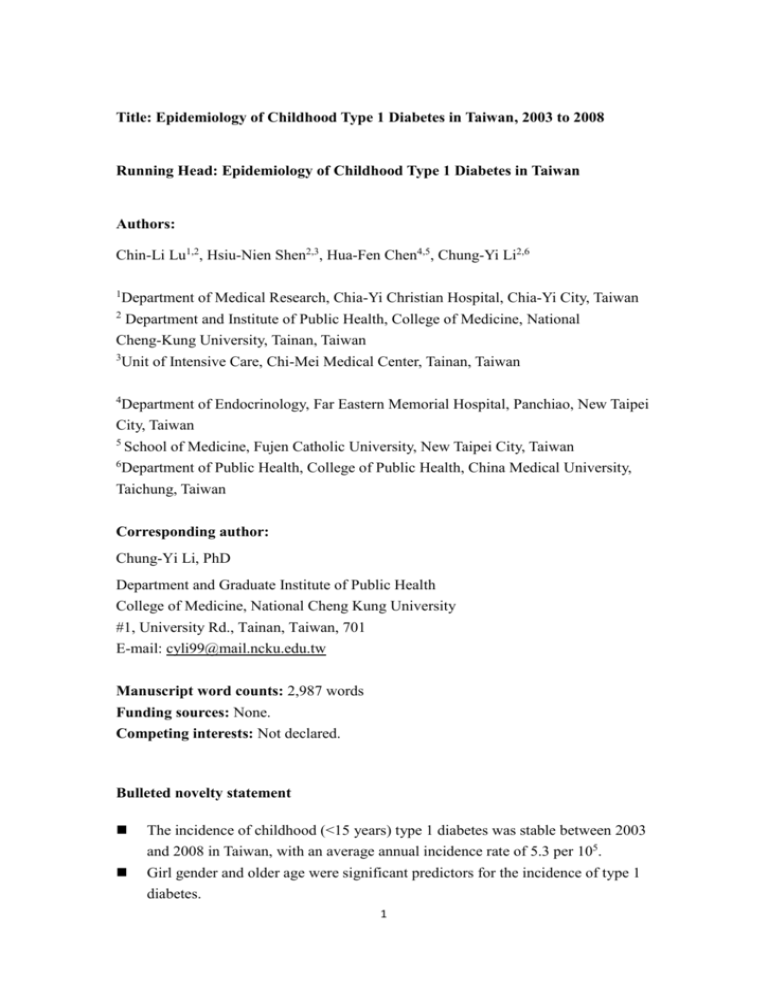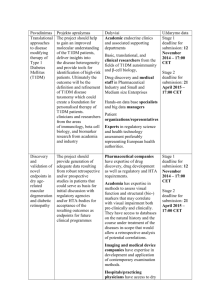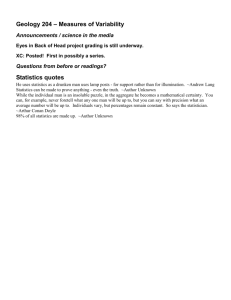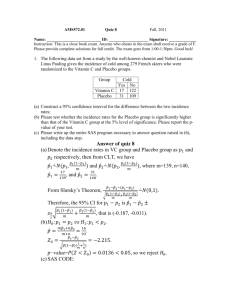Title: Epidemiology of Childhood Type 1 Diabetes in Taiwan, 2003
advertisement

Title: Epidemiology of Childhood Type 1 Diabetes in Taiwan, 2003 to 2008 Running Head: Epidemiology of Childhood Type 1 Diabetes in Taiwan Authors: Chin-Li Lu1,2, Hsiu-Nien Shen2,3, Hua-Fen Chen4,5, Chung-Yi Li2,6 1 Department of Medical Research, Chia-Yi Christian Hospital, Chia-Yi City, Taiwan 2 Department and Institute of Public Health, College of Medicine, National Cheng-Kung University, Tainan, Taiwan 3 Unit of Intensive Care, Chi-Mei Medical Center, Tainan, Taiwan 4 Department of Endocrinology, Far Eastern Memorial Hospital, Panchiao, New Taipei City, Taiwan 5 School of Medicine, Fujen Catholic University, New Taipei City, Taiwan 6 Department of Public Health, College of Public Health, China Medical University, Taichung, Taiwan Corresponding author: Chung-Yi Li, PhD Department and Graduate Institute of Public Health College of Medicine, National Cheng Kung University #1, University Rd., Tainan, Taiwan, 701 E-mail: cyli99@mail.ncku.edu.tw Manuscript word counts: 2,987 words Funding sources: None. Competing interests: Not declared. Bulleted novelty statement The incidence of childhood (<15 years) type 1 diabetes was stable between 2003 and 2008 in Taiwan, with an average annual incidence rate of 5.3 per 105. Girl gender and older age were significant predictors for the incidence of type 1 diabetes. 1 Despite that the rate of admission in type 1 diabetes substantially reduced by 60% over the study period, diabetes ketoacidosis still accounted for 24.6% of all admissions in type 1 diabetes in 2007-2008, and remained the major diabetes complication leading to admission within the first year following the incidence of T1DM. 2 Abstract Aims: To report the annual incidence rate as well as the socio-demographic and clinical characteristics of childhood type 1 diabetes (T1DM) in Taiwan throughout 2003 to 2008. Methods: A total of 1,306 incident cases with childhood T1DM (aged 0 to 14 years) were identified from Taiwan’s National Health Insurance claim datasets throughout 2003 to2008. Temporal trend of incidence rate of T1DM, features of hospitalizations within the first year after diagnosis were investigated. Ecological associations of patients’ characteristics, as well as children population density and urbanization level of residential areas with the risk of T1DM were assessed by using multivariate Poisson regression analysis. Results: The annual incidence rate was stable, irrespective of age and gender, with an average annual incidence rate of 5.3 per 105. Girls were more likely than boys to develop T1DM (6.0 versus 4.7 per 105); the incidence rate increased with age. No apparent geographic variation in incidence rates. Despite the rate of admission substantially reduced by 60% (11.0% to 5.8%) over the study period, diabetes ketoacidosis remained the major diabetes complication leading to admission in 3 childhood T1DM. The multivariate Poisson regression analysis suggested that girl gender and older age were the significant predictors for T1DM incidence, though child population density and urbanization level of residential area were not. Conclusions: Girls and older children should be in particular attention in formulating preventive strategies targeting T1DM. Additionally, clinicians should still carefully manage the child patients with T1DM in order to further reduce the occurrence of DKA. Keywords: Type 1 diabetes; Epidemiology; Ketoacidosis;Temporal trend;Taiwan 4 Introduction Type 1 diabetes (T1DM) is commonly considered as an autoimmune disease. Patients with T1DM usually have the first-attack during their young-ages and are cumbered by disease complications and suffer from lifelong daily treatment. The annual incidence rate of childhood T1DM increased by an average of 3-4% during 1989-2008 across European countries [1]. Moreover, apparent geographic variations in T1DM incidence have been reported [1, 2]. Despite the incidence of childhood T1DM is relatively low in Asia than in Western countries [3, 4], several studies reported an increase in T1DM incidence in some parts of Asia. Nevertheless, most of the data are limited to regional community surveys or institutional / medical center data [3]. Except the WHO DIAMOND project conducted in 1990 to 1999, population-based incidence data were rarely reported on Asian including Taiwan. There is a debate over the explanations for the increasing trend and geographic variations in childhood T1DM incidence. Hygiene hypothesis is among the most likely explanations [5]. It states that the immunological challenges of microbes to human’s early life may promote the maturity of their immune system and protects them from having some allergic and autoimmune disease, such as T1DM [5, 6]. 5 Several measurements had been used to assess hygiene status, e.g., social mixing and infectious contacts [7] , the urbanization level of residents [8], the household crowding status [9], attendance to day-care center [10], and population density [11]. However, the findings of whether these measurements associated with the incidence of T1DM varied and were inconclusive in the literatures. Data on childhood T1DM incidence and secular trend are limited in Taiwan. Jiang et al. reported a population-based incidence of T1DM among those aged 0-19 years in Taiwan through 2000 to 2009. But Jiang et al.’s study provided no age-specific data, which make it hard for international comparisons [12]. We sought to investigate the recent secular trend of the childhood T1DM incidence in Taiwan, and to examine whether or to what extent population-density and urbanization level are associated with incidence of T1DM. Causes of admission for T1DM child patients in the first year of disease onset were also examined. Data analyzed in this study were derived from Taiwan’s National Health Insurance Research Database (NHIRD) that provides a valid and nation-wide registration system for T1DM. 6 Patients and Methods Data Source Data were retrieved from Taiwan’s NHIRD which stores beneficiary’s records and medical claim data from medical institutions. The National Health Insurance (NHI) is provided by the Taiwanese government, it universally covers medical insurance for almost all (>97%) citizens (the criminals and military personnel exempted)[13]. The NHIRD is composed of several parts, including inpatient and outpatient medical claims, registry of catastrophic diseases, basic properties of hospitals, and demographic characteristics of patients. Individual person and institution cannot be identified under the protection of encrypted identification number. To ensure the accuracy of the claims, the Bureau of NHI performs quarterly expert reviews on a random sample of ambulatory and inpatient claims[14]. Full review by Institutional Review Board was exempted because the procedure of encrypting the identification number makes it impossible to identify individuals. Access to the NHIRD datasets is approved by the National Health Research Institutes Review Committee. Study Materials This cross-sectional descriptive study investigated the characteristics of the 7 youths with a new-onset T1DM through 2003 to 2008 and their clinical features within the first year after diagnosis. [We only included claims within such a short period of time, mainly because the coding system for Catastrophic Disease Database in NHI in Taiwan started to introduce a double coding mechanism since year 2002. Certificates of catastrophic diseases issued after 2002 are considered more accurate. Additionally, only claim data in years of 2009 or earlier are available at the time of data access application.] T1DM but not type 2 diabetes has been included on the list of catastrophic diseases of NHIRD which provides good validation of disease diagnosis through an expert-review process. Individual who is going to be registered in the Catastrophic Disease Database for T1DM should provide a physician’s certificate of diagnosis, medical records and relevant examination data (including fasting or glucagon-stimulated C-peptide level, anti-GAD antibody level and history of diabetic ketoacidosis) to the review board. Once the applications are approval, they can be exempt from any co-payment for medical services. From 2003 to 2008, all of the incident cases of T1DM aged 0 to 14 years in Taiwan were identified if they were first registered in the catastrophic disease database for being diagnosed as T1DM, which was determined by diagnosis codes of 250.x1 or 250.x3 based on the coding system of International Classification of Disease, 9th revision, Clinical Modification. (ICD-9th-CM). 8 We linked all incident T1DM cases to the inpatient claims searching their information on possible admissions and the principal cause of each admission during the first year after the T1DM was registered. We looked into several principal causes of admission, including diabetic ketoacidosis (DKA, coded as 250.1x), hyperglycemia (coded as 250.02 and 250.03), hypoglycemia (coded as 250.8, 251.0, 251.1 and 251.2), other diabetes-related (coded as 250.xx, but not including DKA, hyperglycemia and hypoglycemia), and non-diabetes related diagnoses (all other codes). Patients’ demographic characteristics such as age, sex, and residential area were retrieved from beneficiary records. Since these three variables were required in the claim database, all of the data can be traced without missing value. Urbanization level of a patient’s residential area was determined by using the method proposed by Liu et al. who classified all 316 cities and townships of Taiwan into different levels of urbanization based on various indicators including population density, proportion of residents with college or higher education, percentage of elderly (>65 years) people, proportion of agriculture workforce, and number of physicians per 105 people [15]. Children’s population size and density in each city/township were obtained from the Ministry of Interior, Taiwan. The child population density was further categorized into six levels by 5 cut-off points (i.e., 10th percentile, 25th percentile, 50th percentile, 75th percentile, and 90th percentile). 9 Statistical Methods The annual incident rate of T1DM was calculated by dividing the number of incident case by mid-year child population in each year; the standard error associated with incidence rate was estimated under the Poisson assumption. For the characteristics of T1DM patients, continuous variables were described by mean and standard deviation (SD), and discrete variables were summarized by count and percentage. Ecological data analyses were performed, using the univariable and multivariable Poisson regression analyses to associate the incidence rate of T1DM with age, sex, urbanization level, and child population density indicated by the number of child population divided by the area in each city / township. Since child population density and urbanization level are highly correlated, a simultaneous adjustment for them should be avoided. We therefore conducted two separate multivariable regression analyses which enrolled each of them in the regression model. The incidence rate ratios (IRRs) and their 95% percent confidence intervals (CIs) were calculated from the regression coefficients and corresponding standard errors of Poisson regression models. To examine the temporal trend of incidence rate across the study period, we treated the calendar year as a continuous variable and testing the statistical significance of regression coefficient. Similar method was applied to test the trend of IRR across levels of various predictors in the multivariable Poisson 10 regression models. Data analyses were performed by using SAS analytical software (version 9.3, SAS Institute Inc., North Carolina, U.S.A.). A -value of 0.05 was considered as the statistical significance level in this study. 11 Results A total of 1,306 T1DM patients aged 0 to 14 years were registered from 2003 to 2008, representing an average annual incidence rate of 5.3 (95% CI=5.0-5.6) per 105. The average annual incidence rate was higher in girls than in boys (6.0 vs 4.7 per 105, p<0.001); and was significantly (p<0.001) increased with advanced ages (0-4 years, 3.3 per 105; 10-14 years, 6.6 per 105). Although the average annual incidence rate was not significantly different across various levels of urbanization and child population density of residential areas, a slightly higher incidence rate was noted in the least crowed areas (i.e., <22 children / km2, 6.7 per 105). In addition, children who lived in the Eastern part of Taiwan experienced a higher incidence rate than those lived in other areas, but again the observed geographic variation was not statistically significant. (Table 1) Table 2 shows the age-and-sex specific annual incidence rate throughout 2003 to 2008. The overall annual incidence rate declined from 2003 to 2005 and then rose thereafter to 2008, but the variation was trivial. For girls, the lowest incidence rate occurred in 2004 and then increased to 2008. For boys, on the other hand, the annual incidence rate was fluctuating. There were no significant secular trends in annual incidence rate of T1DM regardless of gender and age. Although the TID incidence 12 rate was quite stable over time, the mean age at the time of T1DM registration significantly increased from 8.93.7 years in 2003 to 9.73.6 years in 2008. Such significantly increasing trend was also noted for girls, but not for boys. The frequencies and clinical features of admissions during the first year after initial T1DM registration are described in Table 3. The mean number of hospitalizations per child declined from 0.36 in 2003 to 0.20 in 2005 but reversely increased to 0.28 in 2007. The prevalence of >=2 admissions declined from 6.7% to 3.7%. The mean number of hospitalizations was higher for girls than for boys through 2003 to 2004, though the difference was reduced after 2005. The 1-year incidence rate of DKA was 11.0% in 2003, and then declined to 5.8% in 2008. Despite the declining trend, DKA remains the leading cause-of-admission among T1DM children in 2008. On the other hand, the incidence rate of hyperglycemia increased from 1.0% in 2003 to 4.7% in 2007 (Table 3). Diabetes-related diagnoses (i.e., ICD-9th-CM codes: 250.xx) accounted for most of the admissions over the study period, with the highest (67.1%) and lowest (46.3%) percentage noted in 2003 and 2005, respectively (Figure 1). While the percentage of admission for DKA decreased from 37.7% in 2003 to 24.6% in 2007, the percentage for hyperglycemia substantially increased from 3.5% to 19.7%. Furthermore, hypoglycemia accounted for 1.8% (in 2006) to 5.9% (in 2003) of total admissions annually (Figure 1). Moreover, we noted that 5 T1DM children (4 13 girls, 1 boy) whose admissions were ended up with in-hospital mortality. The duration of T1DM ranged from 2.9 months to 40.1 months. The principal diagnosis at discharge for those deceased children included defibrination syndrome, Poisoning by benzodiazepine-based tranquilizers, lymphoid leukemia, and DKA (n=2) (Data not shown in Tables). Results from the Poisson regression model were shown in Table 4. After adjustment for other covariates, girls were found to be more likely than boys to develop T1DM (IRR=1.27, 95% CI=1.14-1.42). Compared to those aged 0-5 years, children aged 6-10 years and 11-14 years were at significantly increased risk of T1DM, with an IRR of 1.65 (95% CI=1.40-1.94) and 1.99 (95% CI=1.70-2.32), respectively. Additionally, compared to those living in areas with lowest child population density, children residing in higher density areas experienced lower IRRs, ranging from 0.67 to 0.82. We also noted lower IRRs (0.91 to 0.94) in children from areas with higher levels of urbanization, as compared to those living in the least urban regions. 14 Discussions This study was based on a nationwide, population-based registry system, and is one of the few reports presenting the incidence rate of childhood T1DM in Asian since 2000. The average annual incidence rate in Taiwan through 2003 to 2008 was 5.3 per105, which is slightly higher than that reported ever in Asian countries. The annual incidence was quite homogeneous during 2003 to 2008, and did not show a significant association with urbanization level and child-population density. In spite of the decrease in prevalence, DKA continued to be the major T1DM complication leading to hospitalization. Several studies have reported the incidence rate of childhood T1DM in different Asian countries during the last decade of the 20th century. These incidence rates reported by China, Hong Kong, Taiwan, Japan, Thailand and Singapore in a range from 0.25 to 3.8 per 105, which are considered low as compared to the figures reported in other parts of the world [4, 16-19]. Although the T1DM incidence rate was considered low in Asian countries, it showed an increased secular trend in both Japan and Singapore [4, 19]. In Taiwan, Jiang and colleagues reported a T1DM incidence of 4.21 per 105 in 2000 and of 5.79 per 105 in 2009 for the children aged 0 to 19 years[12]. Our study provided further information on age- and sex-specific incidence rate in children aged 0-14 years. A higher incidence rate of childhood T1DM noted in Taiwan may imply a higher prevalence of risk factors etiologically relevant to the development of childhood T1DM. Further investigations are needed to substantiate this speculation. Our study found that the incidence rate of childhood T1DM increased with age in both sexes, which was consistent with the findings reported in most previous 15 studies [1, 20]. Dissimilar to the scenario in Western countries, suggesting that younger children aged 0-4 years showed the most rapid increase in incidence rate [21, 22], our study showed no significant change of the age-specific incidence rates through the study period. In addition to the effect of age, the gender difference in T1DM incidence was examined in many previous studies. Gender difference in T1DM incidence was occasionally found in Western countries, but an increased incidence of T1DM among female youths was consistently reported in Asian studies [1, 16, 17]. Like many Asian studies, our study also showed an excess T1DM incidence in females. The gender difference became significant in children aged 5 years and older. Karvonen et al. analyzed T1DM incidence data of 76 populations based on the DIAMOND project, and found that the populations with low incidence were more likely to be female excess and those with high incidence were more likely to be male excess [23]; The incidence rate reported in our study (i.e., 5.3 per 105) was considered as ‘low-incidence category’ (<6.5 per 105 persons) according to the DIAMOND project, which found that 88% of low-incidence populations were female excess. Svensson et al. examined the interactions between gender and some of the T1DM risk factors, and found that neonatal infection and vitamin D supplementation were related to an increased risk of T1DM in males, but were related to a decreased risk in females [24]. Such observation may imply a possibility that some environmental risk factors may act differently on boys and girls. Children in high-incidence and low-incidence populations may be exposed on different types and levels of risk factors (e.g., childhood infections) leading to different risks of T1DM between boys and girls. Despite the declining trend, diabetic ketoacidosis (DKA) was the major 16 complication leading to admission in the Taiwanese children with T1DM. The average annual DKA admission rate (6.5%) was similar to those reported from many previous studies (1% to 18%)[25]. However, our study included the DKA admissions occurring only in the first year of T1DM registration. Since the glycemic control tends to be unstable in the very first period of having T1DM, our study might be subject to over-estimation of DKA admission when comparing to other studies involving mainly prevalent cases. Nonetheless, our study showed that the DKA admission rate decreased from 2003 to 2005, and then slightly bounded thereafter. Such secular trend warrants caution, and more efforts are needed to further reduce the DKA admission rate. Constructing an educated and supportive environment in schools (i.e., providing training and intensify the role of school personnel[26]) may help a better management of diabetes in school and further reduce the episode of DKA and other T1DM complications, since a majority of T1DM patients were schoolchildren who spend most of their daily activities at schools. The frequency of person-to-person contacts in a child’s early life has been considered as a possible factor, that may protect incidence of T1DM[27]. But not all studies agree with this argument [28]. Holmqvist et al. found that the T1DM risk in semi-rural areas was the highest in South-eastern Sweden[11]; Staines et al. found that the risk of T1DM was positively associated with the population density in UK[29]; though Miller et al. did not find such association in New Zealand[30]. Our study results did not show a significant association of incidence of childhood T1DM with urbanization level of residence and child-population density. The inconsistent findings from various studies might be due to the use of different proxies for person-to-person contact in those studies. Additionally, the lifestyles and social cultures may also affect the migration and population mix, which in turn makes 17 comparisons between studies difficult. There were several limitations in our study. First, since it used ecological data, the geographic features may not be able to fully represent the exposure level of each individual. For example, a child living in an area with high child-population density may not necessarily experience high person-to-person contact or population mix. Second, despite that there is a strong economic incentive (i.e., exempt from co-payment) for registering as a patient with T1DM, time-lags from the date of disease onset to the application date of registration still existed. However, it is believed that the time-lag was small since most of the patients (or their families) are expected to submit their application for T1DM registration soon after they were diagnosed because they can be exempted from co-payment in medical services for T1DM once they are registered. This study also has several strengths. The registration system of catastrophic diseases in Taiwan provides a good validation of disease diagnosis, for conferring a qualification to the suffered children exempting for co-payment, the medical records and diagnosis have been ascertained by a second source, i.e., peer-review board. Based on the universal coverage system, all childhood T1DM patients were enrolled in the study and a nationally representative sample can be assumed in our study. Another strength may include the updated T1DM incidence data in Asian child populations, and the information on age- and sex-specific T1DM incidence. Compared to most previous reports in Asia, this study presented a relatively high but stable incidence rate of childhood T1DM in Taiwan throughout 2003 to 2008. Female youths were predominant in children with T1DM, and those aged between 10 and 14 years had the highest incidence rate. Although the incidence rate decreased 18 over the study period, the DKA remained the major complication leading to admission during the patients’ first year following registration. This study also showed no apparent geographic variation in T1DM incidence in Taiwan, and found no association of T1DM incidence with selected population mix indicators such as urbanization level and child population density. 19 Funding sources: None. Competing interests: Not declared. Acknowledgement This study is based on data from the National Health Insurance Research Database provided by the Bureau of National Health Insurance, Department of Health and managed by National Health Research Institutes. The interpretation and conclusions contained herein do not represent those of Bureau of National Health Insurance, Department of Health or National Health Research Institutes. 20 Reference 1. Karvonen M, Viik-Kajander M, Moltchanova E, Libman I, LaPorte R, Tuomilehto J. Incidence of childhood type 1 diabetes worldwide. Diabetes Mondiale (DiaMond) Project Group. Diabetes care. 2000 Oct;23:1516-26. 2. Soltesz G, Patterson CC, Dahlquist G, Group ES. Worldwide childhood type 1 diabetes incidence – what can we learn from epidemiology? Pediatr Diabetes. 2007;8:6-14. 3. Group DP. Incidence and trends of childhood Type 1 diabetes worldwide 1990-1999. Diabet Med. 2006 Aug;23:857-66. 4. Kawasaki E, Matsuura N, Eguchi K. Type 1 diabetes in Japan. Diabetologia. 2006 May;49:828-36. 5. Okada H, Kuhn C, Feillet H, Bach JF. The 'hygiene hypothesis' for autoimmune and allergic diseases: an update. Clin Exp Immunol. 2010 Apr;160:1-9. 6. Yazdanbakhsh M, Kremsner PG, van Ree R. Allergy, parasites, and the hygiene hypothesis. Science. 2002 Apr 19;296:490-4. 7. Miller LJ, Pearce J, Barnett R, Willis JA, Darlow BA, Scott RS. Is population mixing associated with childhood type 1 diabetes in Canterbury, New Zealand? Soc Sci Med. 2009 Feb;68:625-30. 8. Rytkönen M, Moltchanova E, Ranta J, Taskinen O, Tuomilehto J, Karvonen M. The incidence of type 1 diabetes among children in Finland—rural–urban difference. Health Place. 2003;9:315-25. 9. Bruno G, Spadea T, Picariello R, Gruden G, Barutta F, Cerutti F, et al. Early life socioeconomic indicators and risk of type 1 diabetes in children and young adults. J Pediatr. 2013 Mar;162:600-5 e1. 10. Haynes A, Bulsara MK, Bower C, Jones TW, Davis EA. Cyclical Variation in the Incidence of Childhood Type 1 Diabetes in Western Australia (1985-2010). Diabetes Care. 2012 Nov;35:2300-2. 11. Holmqvist BM, Lofman O, Samuelsson U. A low incidence of Type 1 diabetes between 1977 and 2001 in south-eastern Sweden in areas with high population density and which are more deprived. Diabet Med. 2008 Mar;25:255-60. 12. Jiang YD, Chang CH, Tai TY, Chen JF, Chuang LM. Incidence and prevalence rates of diabetes mellitus in Taiwan: analysis of the 2000-2009 Nationwide Health Insurance database. J Formos Med Assoc. 2012 Nov;111:599-604. 13. Lu JF, Hsiao WC. Does universal health insurance make health care unaffordable? Lessons from Taiwan. Health affairs. 2003 May-Jun;22:77-88. 14. Cheng TM. Taiwan's new national health insurance program: genesis and experience so far. Health affairs. 2003 May-Jun;22:61-76. 15. Liu CY, Hung, Y.T., Chuang, T.L., Chen, Y.J., Weng, W.S., Liu, J.S., Liang, K.Y. Incorporating Development Stratification of Taiwan Townships into Sampling 21 Design of Large Scale Health Interview Survey. Journal of Health Management. 2006;4:1-22. 16. Li XH, Li TL, Yang Z, Liu ZY, Wei YD, Jin SX, et al. A nine-year prospective study on the incidence of childhood type 1 diabetes mellitus in China. Biomed Environ Sci. 2000 Dec;13:263-70. 17. Huen KF, Low LC, Wong GW, Tse WW, Yu AC, Lam YY, et al. Epidemiology of diabetes mellitus in children in Hong Kong: the Hong Kong childhood diabetes register. J Pediatr Endocrinol Metab. 2000 Mar;13:297-302. 18. Panamonta O, Laopaiboon M, Tuchinda C. Incidence of childhood type 1 (insulin dependent) diabetes mellitus in northeastern Thailand. J Med Assoc Thai. 2000 Aug;83:821-4. 19. Lee WW, Ooi BC, Thai AC, Loke KY, Tan YT, Rajan U, et al. The incidence of IDDM in Singapore children. Singapore Med J. 1998 Aug;39:359-62. 20. Harron KL, McKinney PA, Feltbower RG, Bodansky HJ, Norman PD, Campbell FM, et al. Incidence rate trends in childhood type 1 diabetes in Yorkshire, UK 1978-2007: effects of deprivation and age at diagnosis in the South Asian and non-South Asian populations. Diabet Med. 2011 Dec;28:1508-13. 21. Variation and trends in incidence of childhood diabetes in Europe. EURODIAB ACE Study Group. Lancet. 2000 Mar 11;355:873-6. 22. Schober E, Rami B, Waldhoer T, Austrian Diabetes Incidence Study G. Steep increase of incidence of childhood diabetes since 1999 in Austria. Time trend analysis 1979-2005. A nationwide study. European journal of pediatrics. 2008 Mar;167:293-7. 23. Karvonen M, Pitkaniemi M, Pitkaniemi J, Kohtamaki K, Tajima N, Tuomilehto J. Sex difference in the incidence of insulin-dependent diabetes mellitus: an analysis of the recent epidemiological data. World Health Organization DIAMOND Project Group. Diabetes/metabolism reviews. 1997 Dec;13:275-91. 24. Svensson J, Carstensen B, Mortensen HB, Borch-Johnsen K, Danish Study Group of Diabetes in C. Gender-associated differences in Type 1 diabetes risk factors? Diabetologia. 2003 Mar;46:442-3. 25. Angus VC, Waugh N. Hospital admission patterns subsequent to diagnosis of type 1 diabetes in children : a systematic review. BMC health services research. 2007;7:199. 26. Peery AI, Engelke MK, Swanson MS. Parent and teacher perceptions of the impact of school nurse interventions on children's self-management of diabetes. The Journal of school nursing : the official publication of the National Association of School Nurses. 2012 Aug;28:268-74. 27. McKinney PA, Okasha M, Parslow RC, Law GR, Gurney KA, Williams R, et al. Early social mixing and childhood Type 1 diabetes mellitus: a case-control study in 22 Yorkshire, UK. Diabet Med. 2000 Mar;17:236-42. 28. Fear NT, McKinney PA, Patterson CC, Parslow RC, Bodansky HJ. Childhood Type 1 diabetes mellitus and parental occupations involving social mixing and infectious contacts: two population-based case-control studies. Diabetic medicine : a journal of the British Diabetic Association. 1999 Dec;16:1025-9. 29. Staines A, Bodansky HJ, McKinney PA, Alexander FE, McNally RJ, Law GR, et al. Small area variation in the incidence of childhood insulin-dependent diabetes mellitus in Yorkshire, UK: links with overcrowding and population density. International journal of epidemiology. 1997 Dec;26:1307-13. 30. Miller LJ, Willis JA, Pearce J, Barnett R, Darlow BA, Scott RS. Urban-rural variation in childhood type 1 diabetes incidence in Canterbury, New Zealand, 1980-2004. Health & place. 2011 Jan;17:248-56. 23 Table 1. Incidence rates of childhood (0-14 years) type 1 diabetes according to children’s characteristics. Incidence rate (per 105 person) Characteristics Overall Sex Girls Boys Age, years 0-4 5-9 5.3 (5.0-5.6) 10-14 Urbanization level I (highest) 6.6 (6.0-7.1) II III IV (lowest) Child population density, children/Km2 <22 22-47 5.3 (4.9-6.0) 5.2 (4.7-5.7) 5.5 (4.6-6.6) 48-104 105-420 421-1266 >=1267 Region Northern Central Southern Eastern Off-shore island 5.2 (4.5-5.9) 5.3 (4.8-5.8) 5.2 (4.3-6.2) 5.2 (4.7-5.8) 6.0 (5.5-6.4) 4.7 (4.3-5.1) <0.001 3.3 (2.9-3.8) 5.5 (5.0-6.0) <0.001 5.0 (4.5-5.6) 6.7 (5.0-8.6) 4.5 (3.5-5.7) 5.1 (4.7-5.6) 5.3 (4.8-5.9) 5.2 (4.6-5.8) 7.2 (5.2-9.8) 3.2 (0.4-11.4) NS, non-significant. 24 P-value NS NS NS Table 2. Age-and-sex specific annual incidence rate of type 1 diabetes among children aged 0 to 14 years throughout 2003 to 2008. Year 2003 2004 2005 2006 2007 2008 P for trend 239 139 100 212 107 105 205 109 96 216 112 104 218 113 105 216 121 95 ---- Overall 5.5 5.0 4.9 Girls 6.7 5.3 5.5 0-4 3.5 4.0 3.4 5-9 8.8 4.4 6.1 10-14 7.2 7.1 6.3 Boys 4.4 4.8 4.4 0-4 3.0 3.0 3.4 5-9 4.3 4.6 4.3 10-14 5.6 6.2 5.2 Age at initial registration, years (Mean± SD) 5.3 5.8 3.7 6.7 6.3 4.9 3.4 4.3 6.4 5.5 6.0 3.5 6.6 7.1 5.1 3.5 4.9 6.3 5.6 6.6 2.9 6.9 8.7 4.7 2.3 4.1 6.5 0.421 0.738 0.577 0.716 0.381 0.412 0.881 0.989 0.428 Case number Girls Boys Incidence rate (per 105) Overall Girls Boys 8.9±3.7 9.1±4.0 8.9±3.8 9.2±3.7 9.3±3.8 9.7±3.6 8.8±3.5 8.9±3.9 9.0±3.6 9.2±3.7 9.5±3.7 9.8±3.4 9.1±3.9 9.3±4.1 8.7±4.0 9.1±38 9.2±3.8 9.5±3.8 25 0.022 0.013 0.477 Table 3. Clinical features of hospitalizations during the first year after initial type 1 diabetes registration. Calendar year of initial registration 2003 2004 2005 2006 2007 No. of patients 239 No. of admissions 85 Total no. of admissions per patient, % 0 77.0 1 16.3 212 71 205 41 216 57 218 61 76.9 16.4 85.9 9.8 83.8 11.1 77.1 19.3 >=2 6.7 7.1 4.4 5.1 3.7 Average no. of admissions per patient, mean±SD Overall 0.36±0.90 0.33±0.73 0.20±0.56 0.26±0.81 0.28±0.58 Girls 0.47±1.10 0.36±0.74 0.19±0.48 0.26±0.76 0.28±0.56 Boys 0.19±0.44 0.30±0.72 0.21±0.65 0.27±0.86 0.28±0.60 Prevalence of principal cause-of-admission, % Non-diabetes related 9.7 12.6 8.5 8.2 8.2 DKA 11.0 8.4 2.3 4.3 5.8 Hyperglycemia 1.0 3.1 0.8 4.7 4.7 Hypoglycemia 1.7 1.5 0.4 0.4 1.2 Other diabetes related diagnoses 5.9 1.5 SD, standard deviation; DKA, diabetic ketoacidosis. 26 3.8 4.7 3.9 Table 4. Incidence rate ratio of type 1 diabetes in relation to demographic and environmental factors. Univariate analysis Year 2003 2004 2005 2006 2007 2008 P-value for trend Sex Boys Girls Age, years 0-5 6-10 11-14 IRR (95% C.I.) IRR (95% C.I.) IRR (95% C.I.) Ref. 0.92 (0.76-1.11) 0.91 (0.76-1.10) 0.99 (0.82-1.19) 1.03 (0.85-1.23) Ref. 0.91 (0.76-1.10) 0.90 (0.74-1.08) 0.97 (0.80-1.16) 1.00 (0.83-1.21) Ref. 0.91 (0.76-1.10) 0.90 (0.74-1.08) 0.97(0.80-1.16) 1.01(0.84-1.21) 1.03 (0.80-1.24) 1.01 (0.84-1.22) 0.4991 1.02(0.84-1.22) 0.498 Ref. 1.27 (1.14-1.42) Ref. Ref. 1.27 (1.14-1.42) 1.27 (1.14-1.42) Ref. Ref. 1.65 (1.40-1.94) 1.99 (1.70-2.32) <0.001 1.65 (1.40-1.94) 1.99 (1.70-2.32) <0.001 Ref. 1.65 (1.40-1.94) 1.99 (1.71-2.32) P-value for trend Child population density, persons/km2 <22 Ref. 22-47 0.68 (0.48-0.96) 48-104 0.77 (0.58-1.04) 105-420 0.80 (0.60-1.05) 421-1266 0.78 (0.59-1.08) >=1267 0.78 (0.59-1.04) P-value for trend Level of urbanization I (highest) II III IV (lowest) P-value for trend Multivariate analysis Model I Model II 0.91 (0.74-1.11) 0.98 (0.80-1.19) 0.94 (0.77-1.15) Ref. Ref. 0.67 (0.47-0.96) 0.79 (0.59-1.06) 0.82 (0.62-1.08) 0.80 (0.58-1.09) 0.81 (0.61-1.07) 0.961 0.91 (0.74-1.11) 0.98 (0.80-1.19) 0.94 (0.77-1.15) Ref. 0.449 IRR: incidence rate ratio. C.I.: confidence interval. IRRs were estimated by using Poisson regression model. 27 100% 90% 80% 70% 60% 50% 40% 30% 20% 10% 0% 5.6% 5.6% 11.3% 20.0% 5.9% 3.5% 19.7% 21.1% 14.6% 37.6% 19.3% 24.6% 36.8% 34.4% 2006 2007 53.7% 46.5% 32.9% 2003 4.9% 1.8% 2.4% 4.9% 31.0% 16.4% 21.1% 24.4% 2004 2005 Year of initial registry Non-diabetes related DKA Hyperglycemia Hypoglycemia Other diabetes related Figure 1. Distribution of principal diagnoses at discharge, 2003-2007 28








